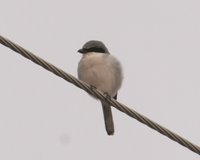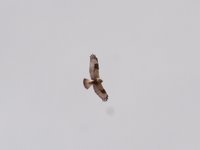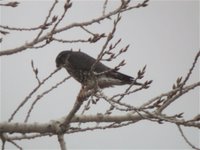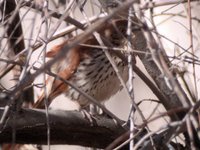I've been participating in the RMBO's Winter Raptor Survey, having done a route in Logan County back in January, and this time doing one in Pueblo County down south. In these surveys, you basically count the number of raptors you see on a 24-mile long route, noting the particulars of the habitat you're in, and being careful of course not to double-count. You stop at specified locations on the route, and count for 3 and only 3 minutes. With a methodical approach it becomes possible to compare like with like and note changes in populations and distributions over time in a large swath of area like Colorado.
I did run into a hitch early on, however, as the route I was given ran through gated private property. Considering I was in the middle of nowhere, I had to improvise a detour for the route, and did my best to link up that detour with the remainder of the specified route. It wasn't perfect, but hopefully my data will still be useful. I did count 61 raptors on the route, including a few of the characters seen here...
 I started off in rural central Pueblo County. The light was lousy (partly cloudy skies at 8am), but I couldn't pass up my first-ever opportunity for a photo of a Prairie Falcon, perched several phone poles ahead of me. For fear of spooking this skittish raptor I opted to stay further back and go for the digiscope shot. A little dark, yes, but a well-behaved bird. I ended up seeing 4 of them on the survey.
I started off in rural central Pueblo County. The light was lousy (partly cloudy skies at 8am), but I couldn't pass up my first-ever opportunity for a photo of a Prairie Falcon, perched several phone poles ahead of me. For fear of spooking this skittish raptor I opted to stay further back and go for the digiscope shot. A little dark, yes, but a well-behaved bird. I ended up seeing 4 of them on the survey. A bit further down the road, I spotted this little guy on my left. I was a little disappointed when I saw that it wasn't a Northern Shrike as I'd hoped (for adding to my photo collection), but rather a Loggerhead Shrike. Note the short bill, and very clean breast - Northerns have longer bills, somewhat streakier breast marks, and a thinner bandito eye-stripe. If there ever was a passerine (i.e., songbird) that deserved mention in the same breath as raptors, it would be a shrike. These birds are sometimes colloquially called "butcherbirds", and for good reason - they often cache their prey (insects, mice, small lizards) by impaling them on thorns or barbs.
A bit further down the road, I spotted this little guy on my left. I was a little disappointed when I saw that it wasn't a Northern Shrike as I'd hoped (for adding to my photo collection), but rather a Loggerhead Shrike. Note the short bill, and very clean breast - Northerns have longer bills, somewhat streakier breast marks, and a thinner bandito eye-stripe. If there ever was a passerine (i.e., songbird) that deserved mention in the same breath as raptors, it would be a shrike. These birds are sometimes colloquially called "butcherbirds", and for good reason - they often cache their prey (insects, mice, small lizards) by impaling them on thorns or barbs. Next up was a highly approachable Ferruginous Hawk, perched on a power pole. I also digiscoped this shot, and for this image I did something a little different, going more for a "portrait" than a full-body pic. Ferruginous Hawks have been wonderfully easy for me to come by so far this year, in contrast to past years where they've been quite rare. What a spectacular bird this is.
Next up was a highly approachable Ferruginous Hawk, perched on a power pole. I also digiscoped this shot, and for this image I did something a little different, going more for a "portrait" than a full-body pic. Ferruginous Hawks have been wonderfully easy for me to come by so far this year, in contrast to past years where they've been quite rare. What a spectacular bird this is.Most of the raptors were along the Huerfano River portion of the route, and those were mainly Red-tailed Hawks and American Kestrels. But I did manage to collect one Rough-legged Hawk circling overhead:
 I've been trying to get a shot of one perched, but I've too often approached too closely for them to stay still. In any case, this was my only Roughie for the survey.
I've been trying to get a shot of one perched, but I've too often approached too closely for them to stay still. In any case, this was my only Roughie for the survey. The survey had just ended 10 minutes previous, and I was steaming down Hwy 50 toward Rocky Ford, when something caught my eye out the passenger window. Flying parallel to me was a kestrel-sized bird, more or less, but this was no kestrel, and I knew it right off - no, this was a Merlin. In my excitement I quickly pulled off the road so I could follow its path into a field. I looked around, and a moment later I saw it perched up in a tree a little ways up the road. I scooted up into digiscope range, and got another bad-light falcon-photo. Again a bit dark, but I felt very gratified to have recognized the bird immediately while driving 70 mph in poor light.
The survey had just ended 10 minutes previous, and I was steaming down Hwy 50 toward Rocky Ford, when something caught my eye out the passenger window. Flying parallel to me was a kestrel-sized bird, more or less, but this was no kestrel, and I knew it right off - no, this was a Merlin. In my excitement I quickly pulled off the road so I could follow its path into a field. I looked around, and a moment later I saw it perched up in a tree a little ways up the road. I scooted up into digiscope range, and got another bad-light falcon-photo. Again a bit dark, but I felt very gratified to have recognized the bird immediately while driving 70 mph in poor light.The Rocky Ford trip was a bust unfortunately, with the weather turning sour in the afternoon. I retired to the motel in Pueblo that night, and on Friday I headed north in much calmer, clearer conditions to El Paso county, to look for a very special bird indeed - the Long-billed Thrasher*, which had been reported at a private ranch a few weeks earlier. This will likely be only the third recorded instance of this species in Colorado, with the first being nearly a century ago. I had to look for this bird.
* In rare bird alerts, the custom for listing extreme rarities is to capitalize all the letters in the bird name, which makes it very attention-grabbing. Really, it's not just a Long-billed Thrasher, but a LONG-BILLED THRASHER. You can practically hear the urgency as you read the report.
 Anyway, when I arrived at the ranch I found neighbor Nick and Cole already there (those bums!), having seen it just moments earlier. But before we could talk much about it we found the Eastern Towhee hanging around. Unfortunately my angle here isn't so great, and it's hard to see the spotless upperwing coverts that make this an Eastern and not a Spotted Towhee. (These two species used to be lumped.)
Anyway, when I arrived at the ranch I found neighbor Nick and Cole already there (those bums!), having seen it just moments earlier. But before we could talk much about it we found the Eastern Towhee hanging around. Unfortunately my angle here isn't so great, and it's hard to see the spotless upperwing coverts that make this an Eastern and not a Spotted Towhee. (These two species used to be lumped.) Ah, a thrasher! But dang, it wasn't the one I wanted. This is the Brown Thrasher, a more common variety found in Colorado (although still pretty unusual in the winter months), and in the next couple hours this little bugger would play havoc with my sensibilities, pretending to be the Long-billed and doing a damn good impression of one. Note though, the very rufous coloration and the light brownish breast streaking. I'd also say to look at the relatively short straight bill, but the bird stayed hidden in the twigs, making a clear shot difficult. Hopefully come spring I'll have a nicer Brown Thrasher photo to show. The point is, Browns and Long-billeds look very much alike, but do have clear differences that are perceptible in the field.
Ah, a thrasher! But dang, it wasn't the one I wanted. This is the Brown Thrasher, a more common variety found in Colorado (although still pretty unusual in the winter months), and in the next couple hours this little bugger would play havoc with my sensibilities, pretending to be the Long-billed and doing a damn good impression of one. Note though, the very rufous coloration and the light brownish breast streaking. I'd also say to look at the relatively short straight bill, but the bird stayed hidden in the twigs, making a clear shot difficult. Hopefully come spring I'll have a nicer Brown Thrasher photo to show. The point is, Browns and Long-billeds look very much alike, but do have clear differences that are perceptible in the field. Over there! Now there's a thrasher with a nice long curved bill, like the Long-billed. But no, that's not it either - the bill is actually too long and too curved, and the breast is dull spotted green-gray, not streaked. This is instead the Curve-billed Thrasher, a very nice bird in its own right, although again not uncommon for Colorado. This digiscoped shot was obtained after about 6 crummy attempts, where the bird hid in the branches and caused the camera to focus on twigs instead of the real subject. Patience finally paid off, and the bird obliged with a wonderful pose.
Over there! Now there's a thrasher with a nice long curved bill, like the Long-billed. But no, that's not it either - the bill is actually too long and too curved, and the breast is dull spotted green-gray, not streaked. This is instead the Curve-billed Thrasher, a very nice bird in its own right, although again not uncommon for Colorado. This digiscoped shot was obtained after about 6 crummy attempts, where the bird hid in the branches and caused the camera to focus on twigs instead of the real subject. Patience finally paid off, and the bird obliged with a wonderful pose. Nick and Cole took off for other locales, leaving me to find the Long-billed on my own. Fortunately, I didn't have to wait too long, and although it skulked in the brambles as advertised (something thrashers love to do in general), it peeked out enough for me to get a few good shots of it. Note here, the much grayer head, the browner back (as opposed to rufous), and the sharper, darker black streaking on the breast. Also, although not seen clearly in this pic, the bill is longer, and curvier than the Brown Thrasher's bill.
Nick and Cole took off for other locales, leaving me to find the Long-billed on my own. Fortunately, I didn't have to wait too long, and although it skulked in the brambles as advertised (something thrashers love to do in general), it peeked out enough for me to get a few good shots of it. Note here, the much grayer head, the browner back (as opposed to rufous), and the sharper, darker black streaking on the breast. Also, although not seen clearly in this pic, the bill is longer, and curvier than the Brown Thrasher's bill.Southern and SE Colorado are great places for birding in the state. If this Long-billed is any indication, I can hardly wait for spring migration to roll around.
tags: birds, Colorado, Pueblo, bird photography

No comments:
Post a Comment